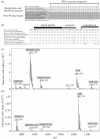A novel form of oxytocin in New World monkeys
- PMID: 21411453
- PMCID: PMC3130245
- DOI: 10.1098/rsbl.2011.0107
A novel form of oxytocin in New World monkeys
Abstract
Oxytocin is widely believed to be present and structurally identical in all placental mammals. Here, we report that multiple species of New World monkeys possess a novel form of oxytocin, [P8] oxytocin. This mutation arises from a substitution of a leucine to a proline in amino acid position 8. Further analysis of this mutation in Saimiri sciureus (squirrel monkey) indicates that [P8] oxytocin is transcribed and translated properly. This mutation is specific to oxytocin, as the peptide sequence for arginine vasopressin, a structurally related nonapeptide, is unaltered. These findings dispel the notion that all placental mammals possess a 'universal' oxytocin sequence, and highlight the need for research on the functional significance of this novel nonapeptide in New World monkeys.
This journal is © 2011 The Royal Society
Figures


References
-
- Young L. J., Wang Z. 2004. The neurobiology of pair bonding. Nat. Neurosci. 7, 1048–105410.1038/nn1327 (doi:10.1038/nn1327) - DOI - DOI - PubMed
-
- Gimpl G., Fahrenholz F. 2001. The oxytocin receptor system: structure, function, and regulation. Physiol. Rev. 81, 629–683 - PubMed
-
- Acher R. 1996. Molecular evolution of fish neurohypophysial hormones: neutral and selective evolutionary mechanisms. Gen. Comp. Endocrinol. 102, 157–17210.1006/gcen.1996.0057 (doi:10.1006/gcen.1996.0057) - DOI - DOI - PubMed
-
- McEwen B. B. 2004. General introduction to vasopressin and oxytocin: structure/metabolism, evolutionary aspects, neural pathway/receptor distribution, and functional aspects relevant to memory processing. Adv. Pharmacol. 50, 1–5010.1016/S1054-3589(04)50001-7 (doi:10.1016/S1054-3589(04)50001-7) - DOI - DOI - PubMed
-
- Gwee P. C., Tay B. H., Brenner S., Venkatesh B. 2009. Characterization of the neurohypophysial hormone gene loci in elephant shark and the Japanese lamprey: origin of the vertebrate neurohypophysial hormone genes. BMC Evol. Biol. 9, 47.10.1186/1471-2148-9-47 (doi:10.1186/1471-2148-9-47) - DOI - DOI - PMC - PubMed
Publication types
MeSH terms
Substances
Grants and funding
LinkOut - more resources
Full Text Sources
